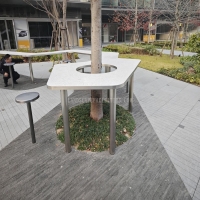Welcome to the website for landscape facilities products and knowledge.
How does the choice of countertop edge design impact the overall safety and aesthetics of a landscape bar counter?
The selection of countertop edge design for landscape bar counters represents a critical intersection of safety considerations and aesthetic aspirations in outdoor living spaces. While often overlooked in initial design planning, the edge profile directly influences both the functional safety and visual harmony of these entertainment focal points.
From a safety perspective, sharp squared edges pose significant risks in outdoor environments where movement may be less predictable. Rounded, bullnose, or eased edges minimize injury potential from accidental impacts, particularly important in spaces where children may be present or where lighting conditions change with natural daylight. The reduced risk of chipping along rounded edges also contributes to long-term maintenance safety by eliminating sharp fracture points that could develop over time.
Aesthetically, edge profiles serve as framing elements that either complement or contrast with the overall design language. A sleek mitered edge might enhance contemporary minimalist designs, while a more elaborate ogee edge could elevate traditional or ornate outdoor kitchens. The edge detail interacts with light differently throughout the day, with beveled edges catching sunlight to create highlight lines that define the counter's shape during daylight hours, while softer edges blend seamlessly into the overall form.
Material thickness further influences this relationship—thicker countertop materials allow for more pronounced edge detailing that becomes a design feature in itself, whereas thinner materials often benefit from simpler profiles that avoid visual top-heaviness. The choice between homogeneous integration (where edge matches countertop material) or contrasting elements (such as metal banding) creates additional layers of visual interest.
Practical considerations include how certain edges affect usability: rounded edges prevent beverage containers from catching on sharp corners, while flat polished edges provide comfortable forearm resting surfaces during prolonged social gatherings. Drainage implications must also be considered—edges with drip grooves or slight downward angles can channel moisture away from seated guests during rainy conditions or after glass condensation.
The relationship between edge design and overall landscape integration cannot be overstated. Edges that mirror architectural elements elsewhere in the outdoor space—such as matching pool coping profiles or echoing deck board patterns—create cohesive design narratives. Conversely, intentionally contrasting edges can make the bar counter stand out as a distinctive feature within the larger landscape composition.
Ultimately, the ideal edge selection balances injury prevention with visual proportionality, maintenance requirements with design longevity, and personal style with contextual appropriateness. This seemingly minor detail proves to be a major determinant in both the safety performance and aesthetic success of landscape bar counters, demonstrating that truly great outdoor design exists where form and function find perfect equilibrium.
Related search:

Recommendation
An outdoor bar counter with stainless steel and terrazzo materials in an irregular shape